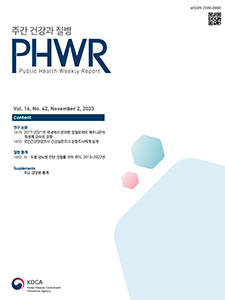Current Issue
Vol.16 No.42, November 02, 2023
-
Original Articles 2023-11-02
 0
0
 829
829
 257
257
Antimicrobial Resistance of Campylobacter jejuni Isolates in the Republic of Korea, 2017–2021
Joohyun Han, Eunkyung Shin, Junyoung Kim, Jaeil Yoo
Public Health Weekly Report 2023; 16(42): 1419-1432 https://doi.org/10.56786/PHWR.2023.16.42.1 Abstract
AbstractCampylobacter is known as one of the representative Intestinal infectious disease. Antimicrobial-resistant Campylobacter has been confirmed to continuously increase, becoming a global health problem. Campylobacter strains in the Republic of Korea (ROK) particularly showed a high rate of quinolone resistance compared to America, Europe, and other countries, raising concerns about quinolone-resistant Campylobacter . This study identified antimicrobial resistance and analyzed trends in Campylobacter jejuni 676 isolates collected from domestic acute and group diarrhea patients from 2017 to 2021. As a result, Campylobacter jejuni isolated in ROK over the past 5 years was confirmed to have a high rate of resistance to nalidixic acid (NAL) and ciprofloxacin (CIP) (quinolones) agents at 84.9% and 84.6%, respectively. Additionally, the tetracycline (TET)-resistance rate increased by 20.3%p, from 16.0% in 2017 to 36.3% in 2021. However, resistance to macrolides, which is recommended as a treatment for Campylobacteriosis, was confirmed only in 1–2 isolates per year, and resistance to other classes of antibiotics was not confirmed. The major antibiotic resistance profiles were NAL-CIP in 393 isolates (58.1%), NAL-CIP-TET in 167 isolates (24.7%), and multidrug resistance (≥3 classes) in 4 isolates (0.6%). By region, at least 76% showed CIP resistance, except for regions where pathogen isolation was not reported. These results suggested that quinolone-resistant Campylobacter could emerge as an increasingly serious public health threat in ROK. And it can be used for the prevention and management of national antibiotic-resistant infections.
-
Original Articles 2023-11-02
 0
0
 864
864
 259
259
Design for Implementation of Rotating Health Survey System for the Korean National Health and Nutrition Examination Survey
Jun Hyun Hwang, Soon-Woo Park, Inho Park, Chaeyun Oh, Sunhye Choi, Kyungwon Oh
Public Health Weekly Report 2023; 16(42): 1433-1451 https://doi.org/10.56786/PHWR.2023.16.42.2 Abstract
AbstractTo improve the usefulness of the Korea National Health and Nutrition Examination Survey (KNHANES) and address emerging health issues, we propose a framework for a rotating survey for the KNHANES, aiming to satisfy the diversification of survey domains or items and minimize the response burden on survey participants simultaneously. To establish a rotating survey system for the health survey of the KNHANES, the research was conducted in the following 5 steps: 1) review and analysis of health survey for the 5th to 9 th KNHANES, 2) first consultation with experts in each domain of health topics, 3) drafting a framework for the rotating system of the KNHANES, 4) second expert consultation, and 5) proposal of the final draft. Core items in all domains are surveyed annually. In the health behaviors domain, after classifying all topics into 5 groups in consideration of the interrelationships between topics, the 6-year survey cycle ( rotating items) was established by assigning the survey cycle differently to 2 years (2 groups) or 3 years (3 groups). The annual average numbers of survey items for 6 years is 197 items (fixed items 179, rotating items 18). Health literacy, digital health, and infectious disease have been proposed as emerging new health issues to be included in the KNHANES. By implementing a rotating survey system, it is expected to reduce the response burden of the survey participants, to increase the efficiency of the survey, and to produce timely health statistics.
-
QuickStats 2023-11-02
 0
0
 739
739
 306
306
Trends in the Doctor’s Diagnosis of Diabetes between Cities or Provinces, during 2013–2022
Public Health Weekly Report 2023; 16(42): 1452-1453 https://doi.org/10.56786/PHWR.2023.16.42.3

pp. 1~2097
Most Keyword
?
What is Most Keyword?
- It is the most frequently used keyword in articles in this journal for the past two years.
Most Read
-
Waterborne and Foodborne Disease Outbreaks in the Republic of Korea, 2023
Myung-Jae Hwang, So Yeon Park, Hyungjun Kim, Se Jeong Yang, Sungchan Yang, Jin Seon Yang
Public Health Weekly Report 2025;18: 17-32 https://doi.org/10.56786/PHWR.2025.18.1.2 -
Implementation Plan for the Coronavirus Disease 2019 Vaccination for the 2024–2025 Season: Recommendations of the 6th Expert Committee on Immunization Practices
Hyewook Hwang, Wookeon Lee, Seohyeon Ahn, Young-Sook Choi, Seunghyun Lewis Kwon, Dongwoo Lee, Eun Hwa Choi, SokGoo Lee
Public Health Weekly Report 2025;18: 90-102 https://doi.org/10.56786/PHWR.2025.18.2.3
Editorial Office
+82-43-719-7569





 Full Text
Full Text Cite
Cite


